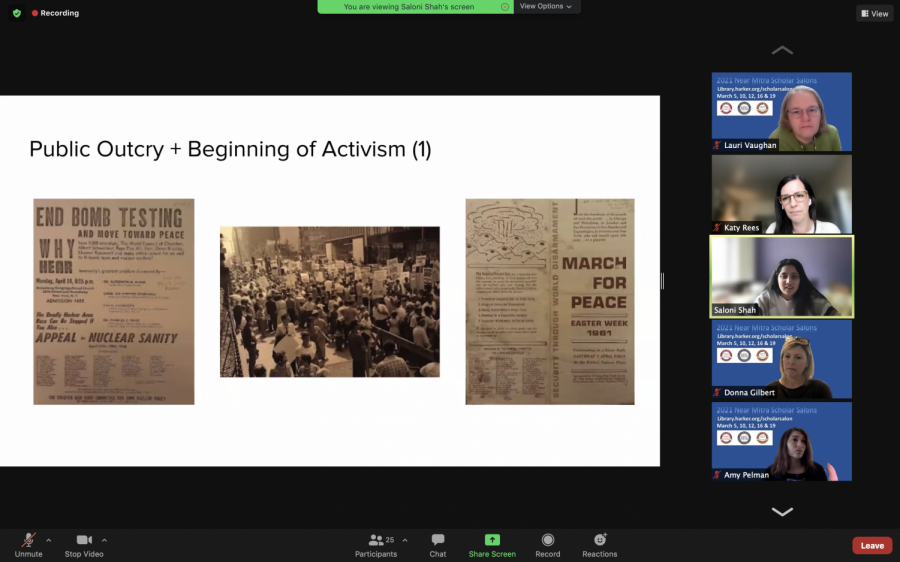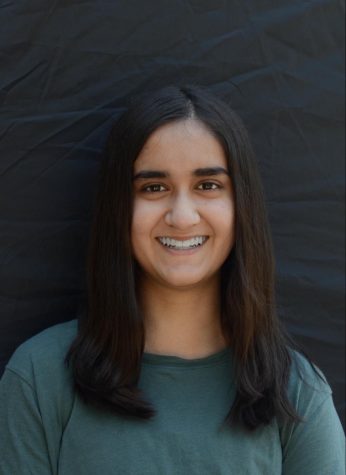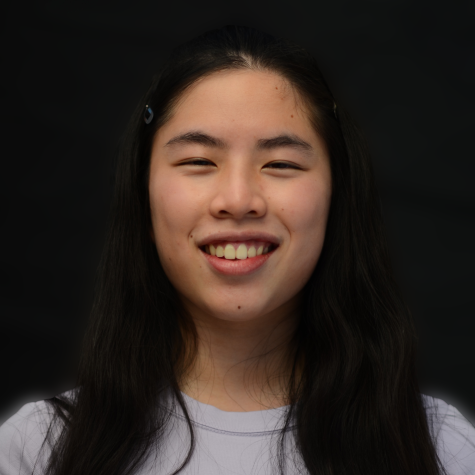Near Mitra Chen Lin scholars present results in inaugural virtual salons
Despite remote learning, scholars conduct research, bridge knowledge gaps in U.S. history, humanities
John Near scholar Saloni Shah (12) shares her research on the Nuclear Freeze Movement in the 20th century during her scholar salon on March 10. “The Near Mitra Chen Lin program is really impactful because it gives you the harmony between being a scholar and a student,” Saloni said in an interview before her salon.
April 7, 2021
Attendees’ faces glow with anticipation as Donna Gilbert and Lauri Vaughan, co-directors of the Near Mitra Chen Lin research program, introduce Sophia Gottfried (12), a Mitra scholar. Sophia begins to present on Friedrich Nietzsche and Emma Goldman, sharing the knowledge she has researched over the past year, and attendees sit back as they enjoy the first scholar salon of the 2020-21 school year.
The Near Mitra Chen Lin research program, formally known as the John Near and Mitra Family Scholar Grant Program and the Chen Lin Family Faculty Grant Program, began a series of scholar salons on March 5, in which the 2021 Near and Mitra scholars present their research to attendees and answer questions.
The Near Mitra program is an endowment in which seniors can apply to have the opportunity to conduct year-long research and write a college-level research paper with the help of a discipline mentor and a librarian mentor. Near scholars write about topics related to United States history, and Mitra scholars write about a topic in the humanities. This article includes an overview of each scholar’s research and their reflections as they near the end of the year.
2021 John Near scholars:
Betsy Tian (12):
Betsy’s salon was held on Friday, March 5, from 3:15 p.m. to 4 p.m. Her research focuses on African American Harlem Renaissance artist Aaron Douglas, and her prompt was the following: “How did Aaron Douglas, influenced by Alain Locke’s philosophy of value and race, defy both social and artistic conventions to re-envision the Black experience in art?” Mentored by upper school art teacher Pilar Aguero-Esparza and upper school librarian Lauri Vaughan, she researched a topic that combines art history and United States history, two subjects she is passionate about.
“When I was making my salon, I thought it would just be really great if the art could speak for itself in that sense,” Betsy said. “I would want people to come and through my presentation, be able to understand the depth of the art and the significance of Douglas’s art. And in that sense, just have the art speak for itself.”
Karan Bhasin (12):
Karan’s salon was held on Friday, March 12, from 2:15 p.m. to 3 p.m., and his research focuses on the emergence of California’s Punjabi-Mexican community, political and economic factors that caused the growth of this community and related topics in ethnicity and culture. Karan read articles detailing how this community is disappearing, which contributed to his desire to conduct research on this topic. His mentors are Mark Janda, upper school history and ethnic studies teacher, Karen Haley, upper school history teacher, and Amy Pelman, upper school librarian.
“[At my salon] I really would just want to give people a viewpoint into a chapter of United States history that a lot of them don’t know about as well as the result of our laws and our economic policies and the unique moments that can arise from that,” Karan said.
Saloni Shah (12):
Saloni’s salon was held on Wednesday, March 10, from 10:15 a.m. to 11 a.m., and her research focuses on the Nuclear Freeze Movement in the 20th century. In her research paper, she argues that the Nuclear Freeze Movement succeeded in reversing the rhetoric of the arms policy of President Reagan and influencing foreign policy. She learned about the effects of nuclear weapons through the Critical Issues Forum at the upper school, and she wanted to research the Nuclear Freeze Movement further through the Near Mitra program because it offers the unique opportunity to read scholarly writing. She researched her topic with the guidance of Katy Rees, upper school history teacher, and Meredith Cranston, upper school librarian.
“The Near Mitra Chen Lin program is really impactful because it gives you the harmony between being a scholar and a student,” Saloni said. “It really emphasizes embracing the uncertainty of learning and then allowing you to dive into a topic — in my case, that’s really emotionally charged — and unravel the complexity behind it and really understand the core of where these movements come from.”
Anna Vazhaeparambil (12):
Anna’s salon was held on Wednesday, March 10, from 12 p.m. to 12:45 p.m., and she researched an American female journalist named Nixola Greeley-Smith and her coverage of the Harry Thaw trial, and how through doing that, she defied expectations of women in the news industry during that time period. She became interested in this topic through her history classes when she learned about journalism throughout history, and her prompt is the following: “How did female journalist Nixola Greeley-Smith’s coverage of the Harry Thaw trial help advance her status in the newsroom and reflect the growing presence of women in the public sphere?”
“My interest in the topic really goes back to being able to look at the history of women in a news industry that has always been very male-dominated and to study what past journalists have done to step ahead in the game and produce work that was unique and different and to make waves,” Anna said. “I don’t think my work is anything like, this individual made a singular breakthrough, but it’s a way to look at a specific aspect of journalistic history and look at it through the context of one individual.”
Nathan Ohana (12):
Nathan’s salon was held on Friday, March 19, from 2:15 p.m. to 3 p.m., and his research focuses on speculative railroad construction and financial methods used leading up to the Panic of 1893. He was interested in researching historical trends and the Gilded Age. His prompt is the following: “To what extent did railroad mismanagement, speculatory line creation, and overly aggressive combinatory practices precipitate bank failures in the lead-up to the Panic of 1893?” His mentors are Julie Wheeler, upper school history and social science teacher, and Pelman.
“Specifically to my topic, there are a lot of lessons that can be learned about bubbles and speculation and the effects they can have on the economy and how it never really ends well,” Nathan said. “So there are a lot of lessons to be learned about stopping that speculation from happening and realizing that speculation and bubble building is happening before it’s too late and the whole economy comes crashing down as a result.”
2021 Mitra Family Scholars:
Andrew Lu (12):
Andrew’s salon was held on Friday, March 12, from 3:15 p.m. to 4 p.m., and through his research he explored key moments of the Soviet Union and the Chinese Communist Party from 1989 to 1991. His prompt is as follows: “How pivotal a role did Soviet geopolitics from 1989-1991 have in influencing the Chinese Communist Party’s political decisions regarding long-term sustainability and the survival of the People’s Republic of China?” He also focused on researching the causes behind the fall of the Soviet Union and reasons why the Chinese Communist Party still exists today. His mentors are Byron Stevens, upper school history teacher, and Pelman.
“I was interested in this topic because a lot of the news and the topic of U.S.-China relations and the ideology behind China has risen to a lot of political discussions recently,” Andrew said. “As the world continues to change, it’s important to understand these perspectives very well and to get the historical foundation to really understand how policymaking and decision making happened, and how it led to the situation we are in today.”
Claire Luo (12):
Claire’s salon was held on Wednesday, March 10, from 9:15 a.m. to 10 a.m., and she researched the Spanish novel The Life of Lazarillo de Tormes and of His Fortunes and Adversities. The anonymously written novel is a piece of 16th century Spanish literature, and Claire was introduced to the novel through her AP Spanish Literature class in junior year. Her mentors are Isabel Garcia, upper school Spanish teacher, and Ms. Vaughan, and her prompt is as follows: “How does the anonymous The Life of Lazarillo de Tormes and of His Fortunes and Adversities lead the way of using the early novel as a means of sociopolitical commentary in sixteenth-century Spain?”
“The work is really fascinating, because it’s obviously published very early on in Spain, but it had so many very forward-thinking ideas and techniques in literature, and it really had a big impact on not just Spanish literature, but world literature in terms of how it really communicated its ideas,” Claire said. “There’s so much written about it, so for me, it’s been really fascinating trying to find what I’m trying to add. What is my unique angle? What message am I trying to do? That, for me, has been just the most fascinating part.”
Arusha Patil (12):
Arusha’s salon was held on Tuesday, March 16, from 3:45 p.m. to 4:30 p.m., and she researched how Dharavi, a slum located in Mumbai, has resisted gentrification, having witnessed firsthand the juxtaposition of skyscrapers located next to slums on a visit to Mumbai in tenth grade. Her mentors are Damon Halback, upper school history and social science teacher, and Ms. Cranston, and her prompt is as follows: “Despite being located in the heart of Mumbai, a bustling metropolitan city often considered the financial capital of India, how has Dharavi, the largest slum of Asia, managed to maintain a unique identity while resisting redevelopment efforts from 1990 to present?”
“I want people to be more aware of the nuances within what we term slums and within settlements that are characterized as low income or homogenous,” Arusha said. “They’re very much homogenized in the sense [that] a lot of the nuance of the individual settlement or slum is reduced, so I really want to encourage people to understand more of [those] communities.”
Sophia Gottfried (12):
Sophia’s salon was held on Friday, March 5, from 2:15 p.m. to 3 p.m., and she spoke about how philosopher Friedrich Nietzsche influenced anarchist Emma Goldman. She wanted to emphasize that Nietszche’s ideas have been used in the left wing of the political spectrum as well, and she chose to research Goldman because she was well-known in her time period but is hardly remembered in history. Sophia’s mentors are Shaun Jahshan, upper school mandarin teacher, and Ms. Cranston, and her prompt is the following: “How did the thinking of philosopher Friedrich Nietzsche influence anarcho-feminist Emma Goldman’s political ideology?”
“I feel like there was this unbalance unfolding where they didn’t talk about all the leftists that utilize Nietzsche. We have very prominent civil rights, particularly Black rights and feminist leaders, who utilized his thoughts as well, so I wanted to give voice to some of that,” Sophia said. “I chose Emma Goldman because her importance relative to how much she was erased is astounding. American textbooks hardly mention her at all, but she was once called by Hoover, the most dangerous woman in America. She was a big deal.”
Aditya Tadimeti (12):
Aditya’s salon was held on Wednesday, March 10, from 1 p.m. to 1:45 p.m., and his research focuses on how Indigenous tribes in Australia used fire to handle the landscape and how fire ultimately caused their downfall. He learned about this topic through a project in which he researched predicting wildfire sizes using machine learning, and he also noticed that many modern fire management methods are similar to original practices. His mentors are Clifford Hull, upper school Latin and history teacher, and Pelman, and his prompt is the following: “How did the use of fire influence indigenous settlement of Australia and incite frontier conflict with European settlers?”
“I would want people to understand that a lot of these Indigenous practices are practices we can learn from,” Aditya said. “From a broader perspective, there’s a lot of value that we can obtain from investigating different cultures and understanding some of their practices despite some of their own differences because in the instance of Indigenous tribes, a lot of them were killed when the Europeans started invading, and a lot of their practices were suppressed without understanding their perspective.”
The scholar salons were introduced this year, and they will continue in future years as a way for the Near Mitra scholars to present their research.
“The idea [of the scholar salons] is that instead of just a really quick webinar at the end of the year [where] everybody gets a minute and a half to talk about something they’ve spent an entire year on, this gives them 45 minutes, or a chunk of time where they can sit down and explain and discuss and share the experience of this entire year that they’ve spent on this particular topic as well as the topic itself,” said Donna Gilbert, upper school history and art history teacher and co-director of the Near Mitra Chen Lin program. “It’s a more informal setting, it allows people to ask questions, and it really honors what these scholars have done because they’ve invested so much time and energy and themselves in each of these projects.”
The Near Mitra program has also embraced the remote learning format, as according to Vaughan, it is possible that future scholar salons will also be held virtually.
“We will be doing these in subsequent years, regardless of whether we’re [in] COVID or not. I think they will always be virtual,” Vaughan said. “This is one of the things we’ve learned about COVID is that this virtual [setting, while] it’s not ideal for a lot of things, it really is cool for a lot of other things, and it’s going to be fabulous [because] we love that people can sit in their living rooms and listen to these scholars talk about their research, and the scholars get a chance to present and get questions.”


















![“[Building nerf blasters] became this outlet of creativity for me that hasn't been matched by anything else. The process [of] making a build complete to your desire is such a painstakingly difficult process, but I've had to learn from [the skills needed from] soldering to proper painting. There's so many different options for everything, if you think about it, it exists. The best part is [that] if it doesn't exist, you can build it yourself," Ishaan Parate said.](https://harkeraquila.com/wp-content/uploads/2022/08/DSC_8149-900x604.jpg)




![“When I came into high school, I was ready to be a follower. But DECA was a game changer for me. It helped me overcome my fear of public speaking, and it's played such a major role in who I've become today. To be able to successfully lead a chapter of 150 students, an officer team and be one of the upperclassmen I once really admired is something I'm [really] proud of,” Anvitha Tummala ('21) said.](https://harkeraquila.com/wp-content/uploads/2021/07/Screen-Shot-2021-07-25-at-9.50.05-AM-900x594.png)







![“I think getting up in the morning and having a sense of purpose [is exciting]. I think without a certain amount of drive, life is kind of obsolete and mundane, and I think having that every single day is what makes each day unique and kind of makes life exciting,” Neymika Jain (12) said.](https://harkeraquila.com/wp-content/uploads/2017/06/Screen-Shot-2017-06-03-at-4.54.16-PM.png)








![“My slogan is ‘slow feet, don’t eat, and I’m hungry.’ You need to run fast to get where you are–you aren't going to get those championships if you aren't fast,” Angel Cervantes (12) said. “I want to do well in school on my tests and in track and win championships for my team. I live by that, [and] I can do that anywhere: in the classroom or on the field.”](https://harkeraquila.com/wp-content/uploads/2018/06/DSC5146-900x601.jpg)
![“[Volleyball has] taught me how to fall correctly, and another thing it taught is that you don’t have to be the best at something to be good at it. If you just hit the ball in a smart way, then it still scores points and you’re good at it. You could be a background player and still make a much bigger impact on the team than you would think,” Anya Gert (’20) said.](https://harkeraquila.com/wp-content/uploads/2020/06/AnnaGert_JinTuan_HoHPhotoEdited-600x900.jpeg)

![“I'm not nearly there yet, but [my confidence has] definitely been getting better since I was pretty shy and timid coming into Harker my freshman year. I know that there's a lot of people that are really confident in what they do, and I really admire them. Everyone's so driven and that has really pushed me to kind of try to find my own place in high school and be more confident,” Alyssa Huang (’20) said.](https://harkeraquila.com/wp-content/uploads/2020/06/AlyssaHuang_EmilyChen_HoHPhoto-900x749.jpeg)








